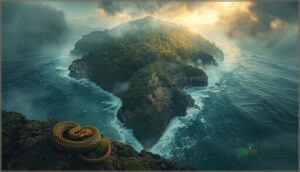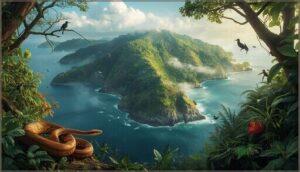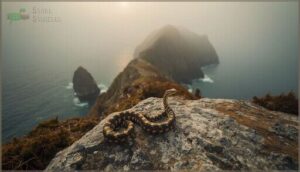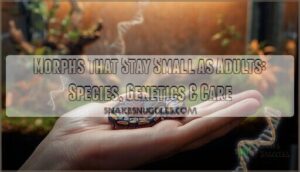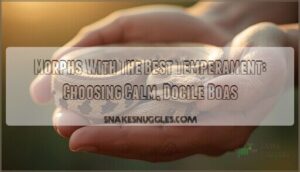This site is supported by our readers. We may earn a commission, at no cost to you, if you purchase through links.
The Brazilian Navy patrols Snake Island, not to keep people out, but to protect the 4,000 golden lancehead vipers that call it home. This 106-acre rock, located 90 miles off Brazil’s southeastern coast, is the last refuge for one of the world’s most venomous snake species.
The island’s unique ecosystem has created an evolutionary pressure cooker, resulting in a species so specialized that it cannot survive anywhere else. With a density of up to five snakes per square meter in some areas, Snake Island is both a death trap and a conservation emergency.
The golden lancehead’s venom is five times more potent than its mainland cousins, a result of 11,000 years of island isolation. This remarkable adaptation highlights the island’s significance as a critical habitat for a species that exists nowhere else on Earth.
Table Of Contents
- Key Takeaways
- Where is Snake Island Located?
- How Snake Island Became Isolated
- The Infamous Golden Lancehead Viper
- Why Snake Island is So Dangerous
- Island Ecosystem and Biodiversity
- Conservation Status of Snake Island
- Access Restrictions and Legal Status
- Scientific Research on Snake Island
- Ongoing Threats and Future Protection
- Frequently Asked Questions (FAQs)
- Is Snake Island illegal to visit?
- How many snakes are estimated to be on Snake Island?
- Can a person go to Snake Island?
- Did anyone live on Snake Island?
- Why is it hard to survive on Snake Island?
- Is it legal to go to Snake Island?
- What is the most snake infested island?
- Does anyone live in Snake Island?
- Why is it illegal to go to Snake Island?
- How many snakes live on Snake Island?
- Conclusion
Key Takeaways
- Snake Island hosts 2,400–4,000 golden lancehead vipers in just 106 acres, creating the world’s highest venomous snake density at up to five snakes per square meter—a concentration that makes every step potentially fatal.
- The golden lancehead’s venom evolved to be five times more potent than mainland relatives due to 11,000 years of isolation, specifically adapted to quickly immobilize migratory birds that became their primary food source.
- The Brazilian Navy enforces a complete access ban to protect both the critically endangered vipers and prevent human deaths, making unauthorized visits illegal and subject to arrest, fines, and criminal charges.
- Rising sea levels and habitat loss threaten the species’ survival despite protection efforts, while illegal wildlife traders target these snakes for the black market, further endangering a population that exists nowhere else on Earth.
Where is Snake Island Located?
You won’t find Snake Island on any tourist map, and that’s by design. This notorious strip of land sits in the Atlantic Ocean, roughly 90 miles off the southeastern coast of Brazil.
Let’s pinpoint exactly where this viper-infested island lies and what makes its location so critical to its deadly reputation.
Geographic Coordinates
You’ll find Snake Island—officially Ilha da Queimada Grande—pinned at approximately 24.48 degrees south latitude and 46.68 degrees west longitude in the Atlantic Ocean. These coordinate systems place this notorious outcrop off southeastern Brazil’s coastline.
Modern geolocation techniques and cartography methods confirm its precise position, though map projections can slightly alter its appearance depending on spatial analysis tools you’re using. Researchers rely on science writing concepts to accurately describe and locate such unique geographical features.
Distance From Brazilian Mainland
Snake Island sits roughly 33 kilometers—about 20 miles—off Brazil’s southeastern coastline near São Paulo state. That stretch of Atlantic Ocean between Ilha da Queimada Grande and the mainland creates a natural barrier that’s kept these deadly vipers isolated for millennia.
- Coastal geography patterns show shallow continental shelf waters gradually deepening as you approach the island
- Nautical distances make unauthorized boat trips risky, with strong currents and tidal shifts complicating access
- Sea level changes over thousands of years transformed what was once connected land into this isolated outcrop
- Oceanic barriers between the island and southeastern Brazil protect both human populations and the snake ecosystem from unwanted contact
The island’s unique ecosystem is an example of ecological research that can provide valuable insights into conservation efforts.
Atlantic Ocean Setting
Beyond that mainland gap, you’ll find Ilha da Queimada Grande surrounded by South Atlantic waters where sea temperatures hover between 23°C and 29°C year-round. Ocean currents shape coastal erosion patterns around Brazil’s notorious snake sanctuary, while tidal patterns influence the tropical island ecosystems here.
Marine life thrives in these subtropical conditions, though the island’s venomous residents remain the real draw for those studying isolated island ecosystems.
How Snake Island Became Isolated
Snake Island wasn’t always a death trap cut off from the world. Around 11,000 years ago, this deadly patch of land was still connected to Brazil’s mainland, allowing animals to move freely between the two.
Then the climate shifted, the ice melted, and rising ocean waters did what no human barrier ever could—they turned a simple hillside into an isolated prison for thousands of venomous snakes.
Sea Level Rise and Separation
You might think an island stays put forever, but Snake Island’s story proves otherwise. Rising sea levels carved this deadly refuge from Brazil’s coast over 11,000 years ago, and they’re still reshaping it today. Coastal erosion and shoreline retreat continue to alter the island’s boundaries, threatening both habitat loss and island submersion in ways that affect every organism there.
Here’s what sea level impact means for tropical island ecosystems like this one:
- Saltwater intrusion degrades freshwater sources the prey base depends on
- Shrinking landmass intensifies ecological isolation and competition for space
- Changing connectivity affects how island ecology reacts to environmental stress
The Golden Lancehead’s future hangs in this precarious balance.
Island’s Geological History
Bedrock tells the real story here. Snake Island’s foundation rests on volcanic and metamorphic rock formed during ancient tectonic activity along the western Atlantic margin, with granitic components recording South American plate collisions that date back to the Cretaceous period. This volcanic formation created the geological isolation necessary for unique island ecosystems to develop. Island arc processes built the substrate, while sea level changes over thousands of years sculpted the terrain you see today. Marine sediments layered atop this foundation reveal how Brazil’s coastline shifted, trapping organisms and setting the stage for ecological isolation that defines island ecology.
| Geological Period | Rock Type | Tectonic Process | Ecological Impact |
|---|---|---|---|
| Cretaceous-Paleogene | Volcanic/Marine Sediments | Island Arc Formation | Created isolated substrate |
| Ancient | Granitic/Metamorphic | Plate Collisions | Built bedrock foundation |
| Quaternary | Terrace Deposits | Sea Level Fluctuations | Shaped current isolation |
| Ongoing | Coastal Sediments | Subsidence/Uplift Cycles | Maintains island separation |
The Infamous Golden Lancehead Viper
The golden lancehead pit viper isn’t just another venomous snake—it’s one of the deadliest serpents on the planet, and it exists nowhere else but this isolated island. You won’t find this species slithering through any mainland forest or zoo exhibit.
Here’s what makes this viper so uniquely dangerous and how thousands of years of isolation shaped it into something truly remarkable.
Physical Characteristics
When you first spot a golden lancehead (Bothrops insularis), you’ll notice the distinctive yellowish-gold trimming along its olive to brown body—a visual signature that gives this pit viper its name. Here’s what makes this venomous snake stand out:
- Adults usually stretch 1.5 to 2.0 meters in length with smooth, glossy scales
- The broad head features a short snout and remarkably large eyes for low-light hunting
- Body coloration provides natural camouflage against leaf litter and forest undergrowth
Their sleek snake anatomy enables both arboreal and ground-based ambush tactics.
Venom Potency and Effects
The golden lancehead’s venom composition packs a devastating punch—its toxicity levels rank among South America’s most potent. It comprises procoagulant enzymes that disrupt blood clotting and neurotoxic components that attack nerve tissue. Bite symptoms escalate rapidly, including intense pain, severe swelling, and tissue necrosis at the site. Systemic effects trigger bleeding disorders, requiring immediate medical treatment to prevent fatal outcomes.
The golden lancehead’s venom ranks among South America’s deadliest, triggering rapid tissue destruction and life-threatening bleeding disorders that demand immediate medical intervention
| Venom Component | Primary Effect |
|---|---|
| Procoagulant enzymes | Blood coagulation disruption |
| Neurotoxic proteins | Neuromuscular paralysis |
| Hemorrhagic factors | Internal bleeding risk |
| Tissue-degrading toxins | Severe necrosis at bite site |
Snake bites from golden lanceheads demand emergency intervention. Envenomation risks multiply without rapid antivenom administration—delays transform survivable encounters into life-threatening crises. Venom research reveals potency variations between individual venomous snakes, complicating treatment protocols. Toxicology studies show median lethal doses markedly lower than mainland relatives, explaining why this isolated population evolved such concentrated firepower for immobilizing migratory birds mid-flight.
Evolutionary Adaptation on The Island
Species isolation transforms ordinary snakes into evolutionary marvels. You’re witnessing island genetics in action—the golden lancehead (Bothrops insularis) demonstrates adaptive traits unlike any mainland relative.
Venom evolution accelerated here, producing toxins five times stronger for capturing migratory birds. Ecological shifts drove morphological changes: elongated fangs, modified jaw structures, altered circadian rhythms.
This species adaptation exemplifies how ecological isolation reshapes biology through evolutionary pressures in restricted island ecology systems.
Why Snake Island is So Dangerous
Snake Island isn’t just home to venomous snakes—it’s overrun by them in numbers that defy common sense. The density of golden lanceheads here creates a landscape where danger isn’t occasional, it’s constant.
Let’s break down what makes this 106-acre rock one of the most hazardous places you could ever set foot.
Snake Population Density
Picture every square meter of forest floor hiding a coiled threat—that’s the reality on Snake Island. The Golden Lancehead population numbers in the thousands, with researchers documenting unusually high encounter rates during field surveys.
You’ll find these venomous snakes concentrated in humid forest understories and rocky outcrops, where habitat fragmentation has intensified population dynamics. Density fluctuation occurs seasonally, with wet periods boosting activity and detectability.
Bothrops insularis thrives here despite ecological balance challenges, creating what some call snake infestations. This isn’t typical snake migration territory—these vipers evolved in isolation, producing concentrated clusters that make every step potentially deadly.
Risks of Venomous Bites
A Golden Lancehead bite transforms from sharp pain into a medical nightmare within minutes. The venom effects hit hard—you’ll experience severe tissue destruction spreading from the wound, accompanied by extensive swelling that can engulf an entire limb.
Snake encounters here carry coagulopathy risks, meaning your blood won’t clot properly, leading to dangerous internal bleeding. Bite symptoms may include vision changes, overwhelming nausea, and muscle weakness as the hemotoxic compounds attack red blood cells.
Emergency response becomes critical since no antivenom exists specifically for this venomous snake species, making toxicology research increasingly essential for future treatment protocols.
Island Ecosystem and Biodiversity
Snake Island isn’t just a rock crawling with venomous snakes—it’s a living laboratory where isolation has shaped every aspect of survival. The island’s ecosystem operates under rules you won’t find anywhere else on Earth, driven by extreme predator-prey relationships and geographic separation spanning thousands of years.
Let’s break down how this unique environment actually functions, from the plants that cling to its slopes to the delicate balance that keeps the golden lanceheads alive.
Unique Flora and Fauna
You won’t find lush rainforests here—Ilha da Queimada Grande sustains stripped-down tropical ecosystems shaped by isolation and predator-prey imbalance. Island biodiversity centers on survival, not variety.
- Endemic species include unique plant varieties clinging to rocky outcrops, adapted specifically to Snake Island’s microhabitats
- Migratory shorebirds nest among limited vegetation, forming the golden lancehead’s primary food source
- Endemic arthropods cycle nutrients through soil where tropical island ecosystems operate on razor-thin margins
Ecological balance hangs by a thread when your top predator outnumbers everything else.
Food Chain Dynamics
When a single dominant predator dominates, food web structure collapses into something strange. Golden lanceheads exert predation pressure on migratory birds and small vertebrates, creating trophic cascades that ripple through this tropical ecology nightmare.
You’re watching predator-prey dynamics gone sideways—where species interactions bottleneck at the top. Ecosystem balance? It doesn’t exist here. Reptile ecology and island ecosystems prove wildlife conservation means protecting fragile, lopsided chains.
Ecological Isolation Effects
Island speciation on Snake Island demonstrates how ecological isolation drives evolutionary consequences. When rising seas cut off the golden lancehead from mainland populations over 10,000 years ago, genetic drift took over. Limited gene flow created distinct genetic markers you won’t find in continental relatives.
This adaptive radiation carved out a unique ecological niche—but isolation also trapped these endangered species in a fragile existence where reptile conservation efforts now race against habitat threats.
Conservation Status of Snake Island
The golden lancehead viper isn’t just dangerous—it’s disappearing. With only a few thousand snakes left clinging to this isolated rock, the species faces threats that make their venomous bite look like the least of their problems.
Here’s what’s pushing these serpents toward extinction and how Brazil is fighting to keep them alive.
Endangered Golden Lancehead Population
You’re looking at a species on the brink. The golden lancehead (Bothrops insularis) population on Ilha da Queimada Grande hovers between 2,400 and 2,900 individuals—a critically endangered species confined to roughly 106 acres.
Conservation efforts face serious challenges:
- Low genetic diversity increases inbreeding risks
- Population decline linked to reduced prey availability
- Habitat loss from environmental changes threatens survival
- Species survival depends on strict protection measures
This isolated viper population represents a conservation priority you can’t ignore.
Threats to Habitat and Survival
Survival pressures on Snake Island squeeze the golden lancehead from multiple angles. Habitat loss fragments populations, while climate shifts alter prey availability and thermoregulation patterns critical for these ectotherms.
Human impact through poaching feeds the illegal wildlife trade, compounding ecosystem disruption. Species invasion threatens native food webs, and ecological isolation—once protective—now limits genetic rescue.
Wildlife conservation efforts face an uphill battle against these converging threats to endangered species preservation.
Government Protection Measures
Through strict access control, the Brazilian Navy guards Snake Island’s fragile ecosystem with unwavering resolve. You won’t set foot here without permit requirements that few researchers ever secure—Navy enforcement keeps unauthorized visitors at bay while protecting both human lives and wildlife.
This government protection exemplifies wildlife conservation efforts at their most decisive, turning ecological preservation into an enforced reality rather than an empty promise.
Access Restrictions and Legal Status
You can’t just decide to visit Snake Island on a whim—Brazil has locked it down tight. The government doesn’t mess around regarding protecting both you and the critically endangered vipers that call this place home.
Here’s how the access restrictions actually work and what happens if you try to break the rules.
Brazilian Navy Regulations
You can’t just sail up to Snake Island—the Brazilian Navy doesn’t allow it. They control access through official decrees and regulatory acts that define who gets near these waters.
Unauthorized entry violates both national security and environmental protection laws, which means real penalties.
The Navy enforces biosecurity protocols, conducts annual lighthouse repairs, and monitors the island to keep out adventurers and bio pirates alike.
Permitted Visitors and Research Protocols
Getting approved for Snake Island requires maneuvering through Brazil’s institutional gauntlet—you’ll need permits from environmental agencies and the Brazilian Navy, plus a compelling research proposal tied to reptile research or herpetological research. Once cleared, you’re not done:
- Visitor screening confirms your credentials and safety training
- Ethics training ensures wildlife protection standards are met
- Safety protocols cover venom exposure and emergency response
- Quarantine rules prevent ecological contamination
Research permissions demand certified doctors on-site during fieldwork.
Penalties for Unauthorized Entry
Trespassing on Snake Island triggers a cascade of legal consequences that Brazil takes seriously. The Brazilian Navy patrols the area and will arrest unauthorized visitors on sight, followed by immediate removal and steep entry fines. Wildlife protection laws authorize criminal charges for conservation violations, enforced by naval and environmental agencies working together to safeguard this critically endangered ecosystem.
| Violation Type | Enforcement Agency | Penalty Range |
|---|---|---|
| Unauthorized landing | Brazilian Navy | Arrest + removal |
| Conservation breach | Environmental agencies | Administrative fines |
| Repeat trespassing | Combined authorities | Criminal charges |
| Smuggling attempt | Federal prosecutors | Imprisonment risk |
Scientific Research on Snake Island
Despite the danger, Snake Island isn’t completely off-limits to science. A handful of researchers have braved the island’s serpent-filled terrain to reveal the secrets of the golden lancehead viper.
Here’s what makes their work both pioneering and incredibly risky.
Herpetological Studies
You won’t find many field sites as unforgiving as this one. Herpetology expeditions here rely on mark-recapture protocols and radio telemetry to track Bothrops insularis movements across the island habitat.
Researchers document golden lancehead snake behavior, reproductive cycles, and reptile ecology under strict ethical permits. Snake biology insights inform species conservation strategies, yet limited access and dense terrain make reptile conservation fieldwork exceptionally challenging.
Venom Research and Medical Potential
The golden lancehead’s venom components drive advanced toxin research. Scientists extract peptides for antivenom development and precision medicine applications, targeting neurological conditions and creating safer analgesics than opioids.
Bioprospecting efforts in toxicology studies reveal how venomous snakes like this one can transform medical treatment. Yet toxinology work here faces steep obstacles: you can’t just walk onto an island where every surface crawls with danger.
Challenges of Conducting Fieldwork
Fieldwork logistics on Snake Island push herpetology research to its limits. You’re battling harsh weather, reptile infestation at every turn, and remote data collection with zero infrastructure backup.
Research permitting takes months, island safety demands specialized medical teams, and ecological monitoring becomes a high-stakes operation.
This ecological isolation protects the snakes—but it also means wildlife research here isn’t just difficult, it’s borderline impossible.
Ongoing Threats and Future Protection
Snake Island’s golden lanceheads face a fight for survival that goes beyond their isolated home. While government restrictions keep most people away, illegal wildlife traders and environmental shifts continue to threaten these critically endangered vipers.
Here’s what’s putting pressure on the population and what experts are doing to turn the tide.
Poaching and Illegal Trade
Greed drives a dangerous trade on Snake Island, Brazil. Wildlife smuggling networks target the golden lancehead pit vipers, pushing this endangered species closer to extinction. Here’s what fuels illegal trafficking:
- Black market dealers pay thousands per snake for exotic pet collectors
- Traditional medicine practitioners seek venom for unproven remedies
- Poaching risks include severe legal penalties and venomous bites
- Remote location complicates enforcement despite Brazilian Navy patrols
- Each capture reduces genetic diversity in an already fragile population
Wildlife conservation depends on stopping these threats.
Conservation Initiatives
Brazil’s government battles poaching through targeted wildlife conservation programs. Since 1985, federal protection status safeguards the island’s ecosystem management needs.
Scientists monitor golden lancehead populations while habitat preservation efforts restore native forest cover critical for prey species.
International herpetology partnerships advance genetic research supporting species protection goals.
You’ll find these conservation efforts emphasize biodiversity preservation and environmental sustainability, turning endangered species preservation from aspiration into action through coordinated reptile conservation strategies.
Sustainable Management Plans
Effective island conservation requires coordinated ecosystem management strategies you can trust. Research permitting protocols now mandate habitat preservation benchmarks, linking field access to measurable conservation efforts.
Environmental monitoring tracks golden lancehead populations, while ecological restoration targets native vegetation critical for prey survival.
You’ll see wildlife preservation succeed when stakeholders align enforcement with ecological protection goals, transforming reactive measures into proactive, science-driven conservation efforts that safeguard this unique Atlantic refuge.
Frequently Asked Questions (FAQs)
Is Snake Island illegal to visit?
Yes, unauthorized visits to Snake Island violate Brazilian conservation laws. The Brazilian Navy patrols approaches to Ilha da Queimada Grande, enforcing strict entry penalties to protect both endangered vipers and uninformed visitors from deadly encounters.
How many snakes are estimated to be on Snake Island?
You’ll find between 2,000 and 4,000 golden lancehead pit vipers on Ilha da Queimada Grande. That’s an astonishing snake population density—these venomous snakes pack into just 106 acres of isolated Atlantic terrain.
Can a person go to Snake Island?
You can’t visit Snake Island without explicit authorization from Brazilian federal authorities. Navy Enforcement and strict Travel Restrictions mean Access Permits are reserved only for approved researchers studying the golden lancehead viper and island ecology.
Did anyone live on Snake Island?
Ironically, the world’s most dangerous island once welcomed human settlements. Lighthouse keepers and their families were former residents until the 1920s, when vipers allegedly drove them from their abandoned homes forever.
Why is it hard to survive on Snake Island?
Hazardous terrain and venomous encounters create survival challenges you can’t ignore. Dense populations of venomous vipers make every step potentially fatal.
Dehydration risks intensify under harsh tropical conditions, while isolation effects limit emergency medical access.
Is it legal to go to Snake Island?
You can’t just book a ticket—visiting Snake Island is completely illegal under Brazilian environmental laws.
Only scientists with rare visitor permits from conservation authorities can legally access this critically endangered viper sanctuary.
What is the most snake infested island?
Snake Island holds the record for the highest venomous snake density anywhere on Earth. The Golden Lancehead population—concentrated exclusively on this Brazilian island—creates an exceptionally dangerous, snake-saturated ecosystem unequaled globally.
Does anyone live in Snake Island?
No permanent human settlement exists on Snake Island.
Research outposts serve scientists briefly, but strict wildlife protection and management by Brazilian authorities prevent any island residents from establishing temporary habitation in this isolated ecosystem.
Why is it illegal to go to Snake Island?
Brazil bans entry to protect you from venomous species and safeguard critically endangered golden lanceheads.
Navy enforcement ensures visitor safety while conservation efforts preserve wildlife protection and management in this ecologically isolated habitat.
How many snakes live on Snake Island?
Field surveys face serious obstacles on this isolated terrain, so you won’t find exact headcounts. Estimates suggest between 2,400 and 2,900 golden lancehead snakes occupy the island—creating remarkable species density.
Conclusion
Snake Island stands as stark proof that preservation sometimes means placing paradise off-limits. You can’t set foot on this deadly refuge, and that’s precisely why 4,000 golden lanceheads still exist.
The Brazilian Navy’s patrols don’t just enforce boundaries—they guard a species teetering on extinction’s edge. Sometimes the boldest conservation act isn’t opening doors for human access. It’s keeping them locked, letting evolution’s last experiment continue undisturbed in its venomous sanctuary.
- https://www.tandfonline.com/doi/abs/10.1080/10871209.2021.1952357
- https://bioone.org/journals/South-American-Journal-of-Herpetology/volume-5/issue-3/057.005.0302/Tail-Luring-by-the-Golden-Lancehead-iBothrops-insularis-i-an/10.2994/057.005.0302.short
- https://www.smithsonianmag.com/science-nature/snake-infested-island-deadliest-place-brazil-180951782/
- https://www.worldatlas.com/articles/brazil-s-forbidden-snake-island.html
- https://a-z-animals.com/animals/golden-lancehead/



